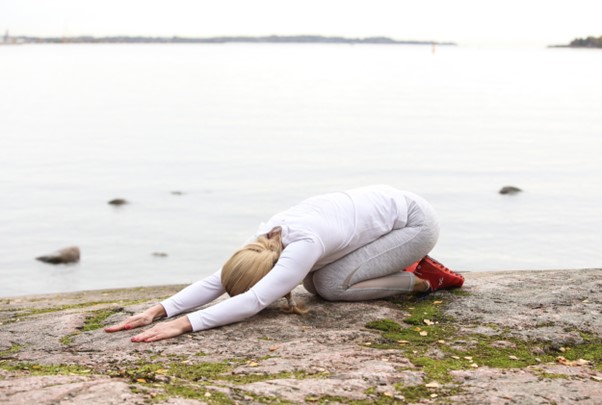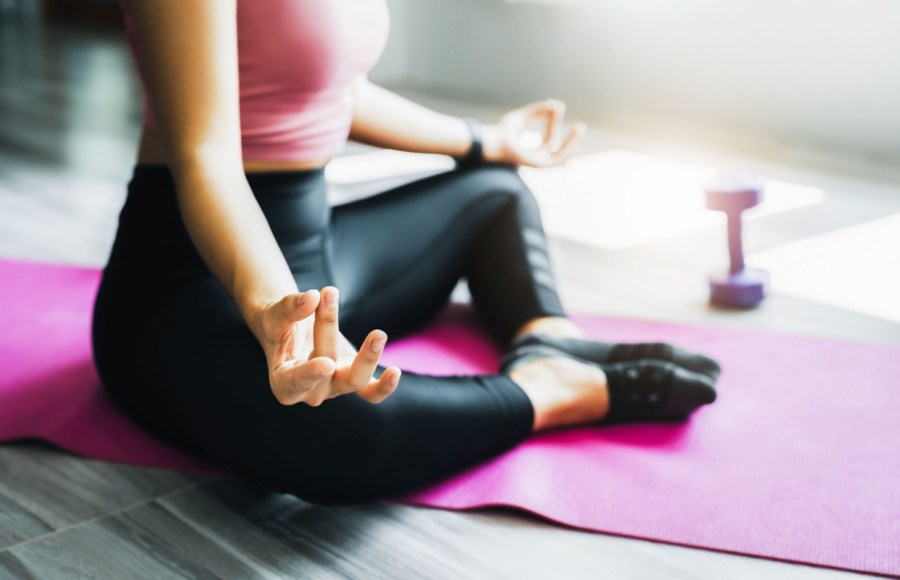We always hear about the importance of regularly exercising your pelvic floor muscles through kegles – but learning how to relax these muscles is just as important. Riina Laaksonen, founder of Nordic Fit Mama, shares her top tips and exercise recommendations…
Related: Pelvic floor workout: 7 best exercises after pregnancy
You need to exercise the pelvic floor, but did you know that you also need to relax it? Tight muscles are not the same as strong muscles. Knowing how to relax your pelvic floor muscles is essential for pelvic health in general and during childbirth in particular.
Pelvic floor muscles that are too tight is a common problem, especially among women (and men) who work out intensively. These important muscles need to be strengthened, but at the same time make sure you know how to correctly relax the pelvic floor muscles. Tight pelvic floor (hypertonia) may result in various health problems, such as pain in the pelvis, buttocks, and lower back, incontinence, painful intercourse, and even clenching of the teeth.
It is good to remember that our bodies is a system. Everything is connected. We are not machines. Our bodies need care and compassion to work correctly.
Relaxing the pelvic floor muscle is, therefore, just as important as strengthening it. Every pelvic floor exercise should include relaxation at the end.
Related: How to fix (and test for) Diastasis Recti at home: 3 best exercises
How to relax the pelvic floor muscles
All kinds of help is now available to take care of the pelvic floor. There’s yoga specifically for pelvic floor, pelvic floor exercises, apps that provide workout instructions, and even gadgets like the Elvie Trainer, that you insert into the vagina and control by phone.
According to research, gadgets are no more helpful than exercise, although they may inspire people to take better care of themselves. There is no harm in experimenting with them, but you can just as effectively take care of yourself without external equipment.
Here are eleven proven ways to relax the pelvic floor muscles:
1. Get to know your pelvic floor and try to relax it consciously
Examining yourself by looking in a handheld mirror is an excellent way to learn to understand your body. Most women have never seen their vaginas, and if this is the case, it is a good idea to take some time to explore what it looks like down there.
The next thing to do is to figure out what happens when you activate the pelvic floor muscles. Insert one or two clean fingers into your vagina and try to squeeze and then relax the pelvic floor muscles. Imagine an upward squeeze, like sucking a straw with these muscles. Can you feel the activation and relaxation in your fingers? Remember to pay attention to your breath. The pelvic floor lowers, and muscles naturally relax during inhalation, while activation is easier during exhalation.
Try to also relax the jaw and mouth consciously. You can let your mouth open, so there is a small gap between your lips. You may notice the relaxation extending to the pelvic floor.

2. Do yoga to relax your pelvic floor muscles
Specific yoga poses such as the deep squat, child’s pose, and happy baby pose relax and open the pelvic floor.
In the child’s pose (pictured above), you kneel and sit on your knees. Bend forward with your knees apart and big toes together and press your forehead lightly on the floor. The hands can be either at the side or stretched forward.
Remember to focus on your breathing while in the pose. Do not hold your breath; let it flow freely. Imagine your pelvic floor relaxing more and more with each breath.
Related: Yoga for stress incontinence: strengthen the pelvic floor
3. Take breaks from sitting
Sitting puts a lot of strain on our bodies in many ways. It is bad for our metabolism and blood flow and is toxic to our pelvic floor. When working in a sitting position, stand up and do small stretches at least every hour.
4. Meditate regularly
Hurry, stress, and worry make our bodies stiff and tighten the pelvic floor muscles. Learning to relax is essential for our mental and physical health and fitness. Try to include stillness in your everyday life. Spend 10-20 minutes a day in a quiet place, with your eyes closed, and focus on your breathing. Observe how you feel. Observe your thoughts but do not get involved in them. Imagine them to be clouds in the sky. Watch them come and go. Embrace everything you feel and think, and do not judge. Let life unfold and happen just the way it does.
5. Do breathing exercises to relax your pelvic floor muscles
Many people breathe too much through their upper bodies and chest, which makes breathing quick and shallow. Diaphragmatic breathing, also known as belly breathing, is more effective because it activates the Vagus nerve, which goes around the diaphragm and is part of our parasympathetic (i.e. relaxing) nervous system.
The pelvic floor muscles are connected to the diaphragm, so belly breathing relaxes and moves the pelvic floor as well. Every time we breathe in and allow the belly to bulge, the pelvic floor and diaphragm relax, and when we breathe out, they are activated.
How to do diaphragmatic breathing:
- Lie down and close your eyes.
- Put your left hand on your chest and your right hand on your abdomen.
- Inhale through your nose so that your belly rises, counting to four. Pay attention to your pelvic floor. Notice how it goes down, like a descending lift, all by itself.
- Hold your breath, counting to two.
- Exhale through your mouth, counting to eight. Keep your jaws and mouth relaxed. Feel your pelvic floor rising.
- Repeat a few times.
Take a few deep diaphragmatic breaths every now and then while breathing, and focus on your pelvic floor. Feel how the pelvic floor relaxes more and more with each breath. Also, do diaphragmatic breathing in the evening before going to bed; it will soon become a habit.
Related: Yogic breathing techniques: how to breathe in yoga

6. Do some deep squats
In India, people spend a lot of time squatting. Good for them, for it is an excellent pose for the body. Kids play naturally in squats.
The deep squat pulls the sacrum back and strengthens the glutes, which support the pelvic floor. When squatting, the pelvic floor opens, and the muscles relax. Try reading the morning papers, browsing social media and even having your morning coffee in a squat. The more you squat, the more you start to crave it. And the deeper the squat, the better.
If you are not mobile enough to be in a deep squat, start by sitting on a low stool or yoga blocks.
7. Use your imagination to relax the pelvic floor muscles
Inside the pelvic floor is a woman’s secret garden. Eastern philosophy calls it the root chakra, located between the coccyx and the vagina. Chakras are the energy centres of the body. The root chakra is said to connect us to the earth and its power. It is the first of the chakras; if it is not in order, the energy does not flow anywhere else in the body.
Whether you believe the Chakra system or not, the idea of a root chakra works as an image. Close your eyes and think of this grounding power centre of yours. Feel how it warms up and how the blood circulates there. You can imagine your pelvic floor as a lotus and focus on feeling how it slowly and pleasantly opens, petal by petal. Take long belly breaths while doing this.
8. Love your body
Women are taught early on that there is always something wrong with how they look. It’s also easy to get the idea from the media that bugs or diseases are constantly lurking, and we are in danger, never doing anything right or enough.
Learn to treat your body as a friend and not as an enemy.
Thank your body for how well it takes care of you. Trust that it works. Listen to its messages and take them seriously. And above all, give your body love.
9. Use the toilet correctly
Sitting on the toilet seat with your back straight puts strain on the pelvic floor and is also a lousy way to do it because, in that position, you have to make an effort to get results. The bladder and bowel may not empty. Up to a third of the pee may remain in the bladder.
Put your feet on a stool when sitting on the toilet seat and lean your back forward. Squatting on the toilet seat would be best if possible.
Also, remember to keep the toilet breaks peaceful. Rushing leads to forcing and straining, and the pelvic floor doesn’t like that. Try relaxing your pelvic floor even when peeing.
Related: How to improve your bowel health
10. Practice belly dancing or hula
Belly dancing and hula are good for your core and pelvic floor. Egyptian belly dancers and Hawaiian hula dancers move gracefully and naturally and have a great mind-body connection. Their pelvic floors are in excellent condition due to their ability to connect with and embrace their femininity, inside out.
11. Indulge in self-love to relax the pelvic floor
Solo sex is an excellent way to get to know your body and pelvic floor. It strengthens and relaxes the pelvic floor muscles, especially if you do it in the butterfly position, i.e, lying on your back with the soles of your feet against each other and your knees apart. Be gentle, use lubricants, and take it easy. Enjoy your body. Pleasure yourself. Remember that hurry and pressure to perform are the worst enemies of sex.
For more advice on how to look after your pelvic floor, plus expert guidance on pre- and post-natal exercise, head to nordicfitmama.com.
Words: Riina Laaksonen | Images: Shutterstock







